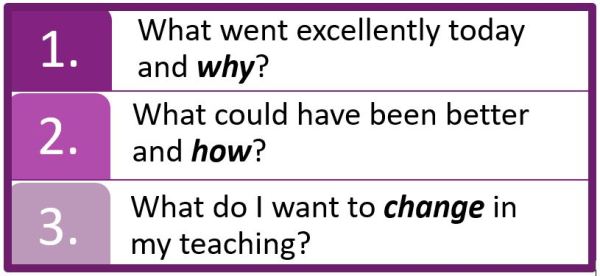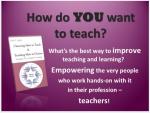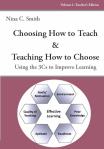Good teachers have strong organizational skills. Good teachers have solid decision-making skills. Good teachers get important things done.
Exceptional teachers do all of the above–and more. Sure, they care about their school and students, their principals and administrators. But most importantly, they care to an exceptional degree about the people who work for them, their students.
That’s why extraordinary teachers give every student:
1. Autonomy and independence
Great organizations are built on optimizing processes and procedures. Still, every task doesn’t deserve a best practice or a micro-managed approach. Engagement and satisfaction are largely based on autonomy and independence. I care when it’s “mine.” I care when I’m in charge and feel empowered to do what’s right.
Plus, freedom breeds innovation: Even heavily product-oriented assignments have room for different approaches.
Whenever possible, give your students the autonomy and independence to work the way they work best. When you do, they almost always find ways to do their jobs better than you imagined possible.
2. Clear expectations
While every assignment should include some degree of independence, every assignment does also need basic expectations for how specific situations should be handled.
Criticize a student for writing an opinion today even though yesterday that was standard practice and you make that student’s learning impossible. Few things are more stressful than not knowing what is expected from one day to the next.
When an exceptional teacher changes a standard or guideline, s/hes communicates those changes first–and when that is not possible, s/he takes the time to explain why s/he made the decision s/he made, and what she expects in the future.
3. Meaningful objectives
Almost everyone is competitive; often the best students are extremely competitive–especially with themselves. Meaningful targets can create a sense of purpose and add a little meaning to even the most repetitive tasks.
Plus, goals are fun. Without a meaningful goal to shoot for, studying is just work.
No one likes work.
4. A true sense of purpose
Everyone likes to feel a part of something bigger. Everyone loves to feel that sense of teamwork and esprit de corps that turns a group of individuals into a real team.
The best courses involve making a real impact on the lives of the students you teach. Let students know what you want to achieve for your class, for your school, and even your community. And if you can, let them create a few lessons of their own.
Feeling a true purpose starts with knowing what to care about and, more importantly, why to care.
5. Opportunities to provide significant input
Engaged students have ideas; take away opportunities for them to make suggestions, or instantly disregard their ideas without consideration, and they immediately disengage.
That’s why exceptional teachers make it incredibly easy for students to offer suggestions. They ask leading questions. They probe gently. They help students feel comfortable proposing new ways to get things done. When an idea isn’t feasible, they always take the time to explain why.
Great teachers know that students who make suggestions care about their learning, so they ensure those students know their input is valued–and appreciated.
6. A real sense of connection
Every student works for a grade (otherwise they would bring you more of their work than just assignments), but every student wants to work for more than a grade: They want to study with and for people they respect and admire–and with and for people who respect and admire them.
That’s why a kind word, a quick discussion about family, an informal conversation to ask if an student needs any help–those moments are much more important than group meetings or formal evaluations.
A true sense of connection is personal. That’s why exceptional teachers show they see and appreciate the person, not just the student.
7. Reliable consistency
Most people don’t mind a teacher who is strict, demanding, and quick to offer (not always positive) feedback, as long as s/he treats every student fairly.
(Great teachers treat each student differently but they also treat every student fairly. There’s a big difference.)
Exceptional teachers know the key to showing students they are consistent and fair is communication: The more students understand why a decision was made, the less likely they are to assume unfair treatment or favoritism.
8. Private criticism
No student is perfect. Every student needs constructive feedback. Every student deserves constructive feedback. Good teachers give that feedback. Great teachers always do it in private.
9. Public praise
Every student–even a relatively poor performer–does something well. Every student deserves appreciation. It’s easy to recognize some of your best students because they’re consistently doing awesome things. (Maybe consistent recognition is a reason they’re your best students? Something to think about.)
You might have to work hard to find reasons to recognize a student who simply (or barely) meets standards, but that’s okay: A few words of recognition–especially public recognition–may be the nudge an average performer needs to start becoming a great performer.
10. A chance for a meaningful future.
Every course should have the potential to lead to greater things. Exceptional teachers take the time to develop students for the course they someday hope to take, even if that course is in another school.
How can you know what a student hopes to do someday? Ask.
Students will only care about your course after you first show you care about them. One of the best ways is to show that while you certainly have hopes for your school’s future, you also have hopes for your students’ futures.
Good advice, isn’t it? Let me confess: these are not my words.
I owe this article to Jeff Haden, who published it in Inc. under the title of extraordinary bosses. I just couldn’t pass the uncanny resemblance between being an awesome boss and being an awesome teacher. So, what I did was just to change words like boss, company, customer and employee to teacher, school and student. With small adaptation it would fit well as a parenting advice, too. It made me think about the best places where I have worked and felt like a valued member of the team.
We have all this good knowledge about leadership (which resembles teaching much more than management does), and how to put it into practice.
Imagine how different education would look like if we treated our students like best companies treat their employees?
Or,
better yet,
if we treated students like valued customers??
Tags: learning, learning facilitation







